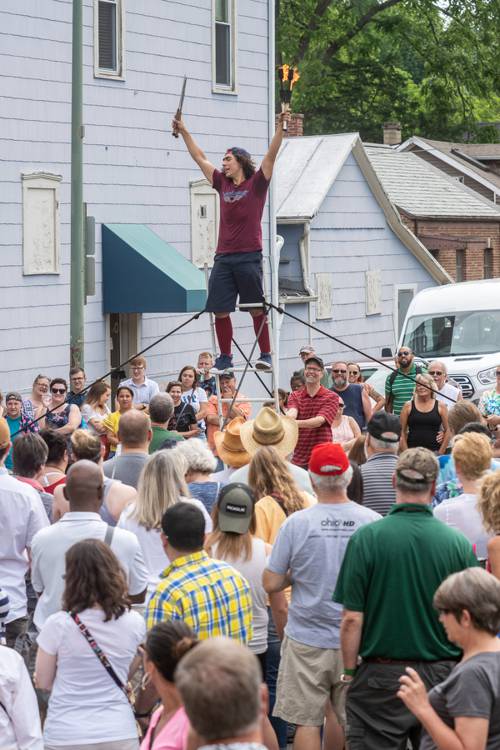
FAQ About The Role of Modern Busking in Urban Cultural Exchange

What is modern busking and how does it differ from traditional busking?
Modern busking refers to street performance conducted in contemporary urban settings, encompassing music, dance, acrobatics, art, and other forms of entertainment. It differs from traditional busking in the diversity of performances and often includes the use of technology, such as amplifiers and digital payment options, to enhance the audience experience. Traditional busking, on the other hand, typically involved acoustic performances and a hat or container for collecting donations.

How does busking contribute to urban cultural exchange?
Busking contributes to urban cultural exchange by bringing diverse art forms and cultures into public spaces, making cultural experiences accessible to a wide audience. Performers from different backgrounds share their unique cultural heritage, music, and traditions, fostering a multicultural dialogue within cities. This spontaneous interaction between the audience and performers helps break down cultural barriers and promotes understanding and appreciation of diverse cultures.

What impact does busking have on local urban music scenes?
Busking has a significant impact on local urban music scenes by providing a platform for emerging artists to showcase their talents and reach new audiences. It introduces new sounds and genres to the local music landscape, encouraging diversity and innovation. Furthermore, busking can inspire local musicians and nurture communities around these performances, often leading to collaborations and opportunities for performers in more formal settings.

Are there any legal regulations for busking in urban areas?
Yes, most urban areas have specific regulations governing busking. These can include requiring permits, restrictions on location and time of day, noise level regulations, and health and safety standards. Regulations vary widely between cities, so performers must research and comply with local laws. Permits help manage public space usage and ensure performers respect residents and other businesses.

How does technology influence modern busking?
Technology influences modern busking in various ways, from enhancing performance quality to enabling new forms of audience interaction. Performers use portable amplifiers, sound equipment, and digital instruments to amplify and diversify their acts. Additionally, platforms for digital payments, like mobile apps, allow audiences to tip performers more easily. Social media also plays a role in promoting buskers and reaching wider audiences.

What types of performances are commonly seen in urban busking?
Common busking performances include musical acts (such as singing, instrumental music, and bands), dance routines, mime and clown acts, acrobatics, magic shows, and live painting or drawing. The diversity of performances varies by location but generally reflects the artistic and cultural richness of the city, offering a wide range of entertainment options for passersby.

Why is busking important for community engagement?
Busking is important for community engagement because it brings art and entertainment directly into public spaces where everyone can enjoy them, reducing barriers to cultural participation. Engaging performances can draw people together, creating communal experiences and social interactions that strengthen community bonds. It also provides moments of delight and reflection, contributing to the vibrancy of urban life.

Can busking help promote tourism in a city?
Yes, busking can enhance a city's appeal to tourists by adding unique, dynamic cultural experiences to urban landscapes. Street performances attract both locals and tourists, offering spontaneous cultural interactions that contribute to a city's charm. This lively atmosphere can create memorable experiences for tourists, encouraging them to spend more time and money in the area.

How do cities support buskers to enhance cultural exchanges?
Cities can support buskers by providing designated performance areas, simplifying permit processes, and fostering busking-friendly policies. Some cities organize festivals and events that highlight busking performances, increasing visibility for artists. By creating safe and welcoming environments, cities encourage buskers to share their art freely, enhancing cultural exchange and community vibrancy.

What challenges do buskers face in urban environments?
Buskers face a variety of challenges in urban environments including obtaining permits, competition for prime locations, weather conditions, noise ordinances, and sometimes, negative perceptions from authorities or the public. They must navigate these challenges while ensuring their performances are engaging and respectful of the local community.

Are there financial benefits to busking for performers?
Yes, busking can offer financial benefits for performers. It provides an immediate source of income through public donations and tips, which can be significant depending on the performer’s skills, location, and audience size. Additionally, busking often leads to other paid performance opportunities, such as private or corporate events, and can help artists sell their music or merchandise.

How do buskers select locations for their performances?
Buskers typically select locations based on foot traffic, visibility, acoustics, and local regulations. Popular spots include busy urban streets, tourist attractions, public squares, and transportation hubs. The goal is to reach the largest and most diverse audience while adhering to any legal requirements that may affect their performance space.

What role does social media play in modern busking?
Social media serves as a powerful tool for modern buskers by enabling them to promote their performances, share their stories, and connect with audiences globally. Platforms like Instagram, YouTube, and TikTok allow buskers to showcase their talents, attract followings, and sometimes monetize their content. This visibility can lead to increased live audience sizes and further opportunities for professional growth.

How does busking differ across cultures and countries?
Busking varies significantly across cultures and countries, influenced by local traditions, legal frameworks, and public attitudes. In some cultures, busking is an ancient and respected form of artistic expression, while in others, it may be viewed as less formal or even discouraged. Different cultural influences affect the styles of performances and the types of music or acts that are popular in specific regions.

Is busking considered a legitimate form of employment?
While not traditionally recognized as formal employment, busking is increasingly seen as a legitimate artistic pursuit that can provide substantial income for some performers. It's a flexible occupation that allows artists to engage directly with audiences and earn based on their performance merits. However, since it doesn't provide employment benefits or consistent income, many buskers view it as part of a broader portfolio of artistic endeavors.

How can busking influence social issues within a city?
Busking can influence social issues by raising awareness and promoting dialogue on various topics through artistic expression. Performers often reflect societal themes in their acts, encouraging audiences to think critically about important issues. Additionally, busking can democratize access to the arts and promote inclusivity, giving voice to underrepresented communities within urban settings.

What is the historical significance of busking in urban areas?
Historically, busking has been a vital part of urban culture, providing entertainment and social commentary for townspeople. It dates back centuries, with origins deeply rooted in festive and community traditions. Buskers have often served as conveyors of news, music, and stories, contributing to the cultural and social fabric of cities, making art accessible to all, regardless of socioeconomic status.

Do busking performances require formal training?
Busking does not necessarily require formal training, although many successful buskers have developed their skills through professional education or self-directed practice. What is essential is the ability to engage with an audience through creativity and authentic performance. Many buskers augment formal training with practical experience gained directly from performing on the streets.

How does busking influence the personal development of performers?
Busking can significantly impact personal development by enhancing performers' confidence, resilience, and adaptability. The immediate feedback and interaction with diverse audiences provide valuable learning experiences that help artists refine their skills and develop their unique artistic voices. This exposure often leads to personal growth and increased professional opportunities.

What responsibility do buskers have towards their local community?
Buskers have the responsibility to respect local laws, cultural sensitivities, and the public spaces they perform in. This includes managing noise levels, ensuring public safety, and maintaining an overall positive experience for the community. By adhering to these responsibilities, buskers contribute positively to the urban environment and foster goodwill with audiences and city authorities.
